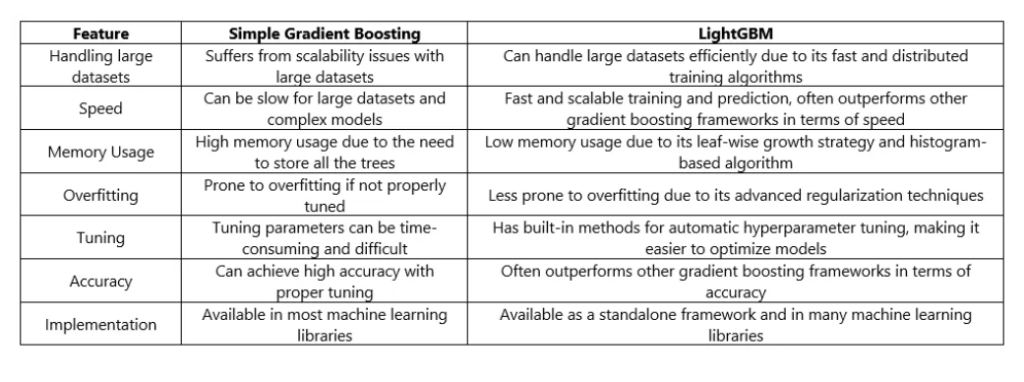Light Gradient Boosting
Table Of Contents:
- What Is a Light Gradient Boosting Algorithm?
- Key Features Of Light GBM.
(1) Light Gradient Boosting.
- LightGBM is another popular gradient-boosting framework that is known for its excellent performance and efficiency.
- It is designed to be a faster and more memory-efficient implementation compared to traditional gradient-boosting algorithms like XGBoost.
- LightGBM introduces several key optimizations to achieve these improvements.
(2) Key Features Of Light GBM.
Gradient-based One-Side Sampling (GOSS): LightGBM incorporates a technique called Gradient-based One-Side Sampling (GOSS) to reduce the number of data instances used for gradient-based decision-making. GOSS focuses on keeping the instances with large gradients while randomly downsampling instances with small gradients. This helps to improve the training speed without sacrificing much accuracy.
Exclusive Feature Bundling (EFB): LightGBM uses a technique called Exclusive Feature Bundling (EFB) to group categorical features into a single feature. This reduces the number of features to consider during the training process and can significantly reduce memory usage.
Light Histogram: Instead of using pre-defined bin boundaries, LightGBM builds histograms of feature values during training. These histograms are then used to find the optimal split points for nodes in the decision trees. This approach reduces the memory consumption and speeds up the training process.
Leaf-wise Tree Growth: LightGBM adopts a leaf-wise tree growth strategy, where it expands the leaf nodes that contribute the most to the loss function’s improvement. This strategy can lead to faster convergence and more accurate models.
Gradient-based Regularization: LightGBM incorporates a gradient-based approach to handle regularization. It applies regularization directly to the gradients during the tree construction process, which helps to control overfitting.
Parallel and GPU Training: LightGBM supports parallel and GPU training, allowing it to take advantage of multi-core CPUs and GPUs to accelerate the training process further.
Handling Large-Scale Datasets: LightGBM is designed to handle large-scale datasets efficiently. It implements data parallelism and distributed computing to train on datasets that exceed the memory capacity of a single machine.
Other Hyperparameters: LightGBM shares several hyperparameters with other gradient-boosting algorithms, such as learning rate, maximum depth, subsample, and regularization parameters. These hyperparameters can be tuned to optimize the model’s performance.
- Accuracy: Light GBM is known for its high accuracy and ability to handle imbalanced datasets. It achieves this by using a variety of techniques, such as gradient-based one-sided sampling, regularization, and data balancing.
- Flexibility: Light GBM offers a wide range of options for model customization and optimization. It includes built-in features for data preprocessing, cross-validation, and hyperparameter tuning, making it easier for users to optimize their models.
- LightGBM is widely used in various machine-learning tasks, including classification, regression, and ranking. Its speed and efficiency make it particularly suitable for large-scale datasets or situations where fast model training is required.
- LightGBM is available in several programming languages, including Python, R, and C++, making it accessible to different users and developers.
(3) Brief Comparison

- In summary, LightGBM offers several advantages over simple gradient boosting, including faster and more memory-efficient training, advanced regularization techniques to reduce overfitting, and built-in methods for automatic hyperparameter tuning.
- It often outperforms other gradient boosting frameworks in terms of speed and accuracy and can handle large datasets efficiently, making it a valuable tool for building machine learning models.

